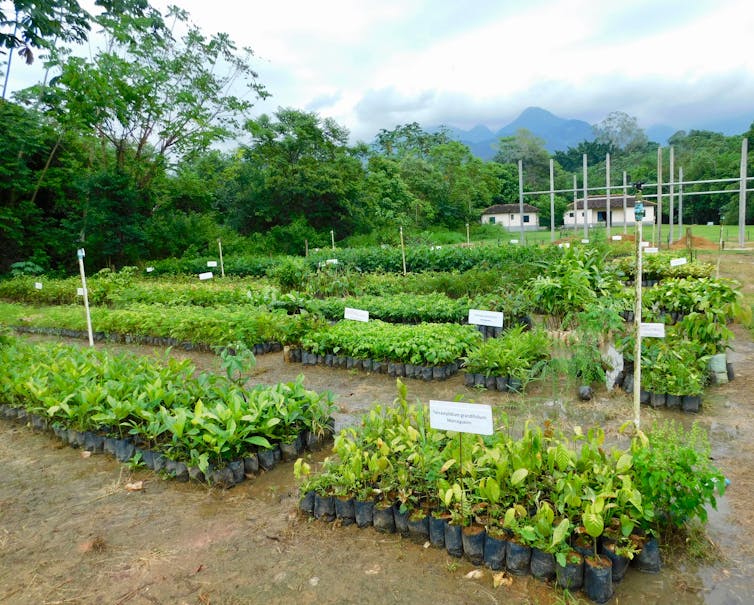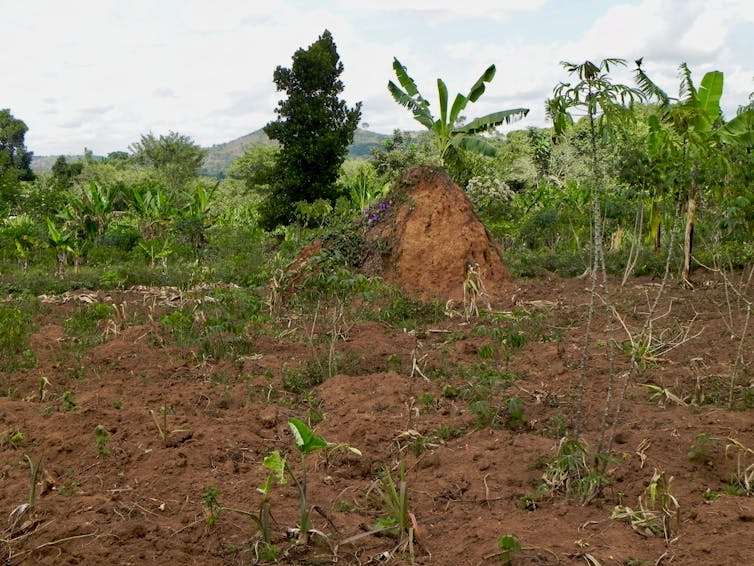High-value opportunities exist to restore tropical rainforests around the world – here's how we mapped them
- Written by Robin Chazdon, Professor Emerita of Ecology and Evolutionary Biology, University of Connecticut
The green belt of tropical rainforests that covers equatorial regions of the Americas, Africa, Indonesia and Southeast Asia is turning brown. Since 1990, Indonesia has lost 50% of its original forest, the Amazon 30% and Central Africa 14%[1]. Fires, logging, hunting, road building and fragmentation have heavily damaged more than 30% of those that remain[2].
These forests provide many benefits[3]: They store large amounts of carbon, are home to numerous wild species, provide food and fuel for local people, purify water supplies and improve air quality. Replenishing them is an urgent global imperative.
But there aren’t enough resources to restore all tropical forests that have been lost or damaged. And restoration can conflict with other activities, such as farming and forestry. As a tropical forest ecologist[4], I am interested in developing better tools for assessing where these efforts will be most cost-effective and beneficial.
Over the past four years, tropical forestry professor Pedro Brancalion[5] and I have led a team of researchers from an international network[6] in evaluating the benefits and feasibility of restoration across tropical rainforests around the world. Our newly published findings identify restoration hotspots[7] – areas where restoring tropical forests would be most beneficial and least costly and risky. They cover over 385,000 square miles (100 million hectares), an area as large as Spain and Sweden combined.
The five countries with the largest areas of restoration hotpots are Brazil, Indonesia, India, Madagascar and Colombia. Six countries in Africa – Rwanda, Uganda, Burundi, Togo, South Sudan and Madagascar – hold rainforest areas where restoration is expected to yield the highest benefits with the highest feasibility. We hope our results can help governments, conservation groups and international funders target areas where there is high potential for success.
 A native tree nursery for large-scale restoration of Atlantic Forest at Reserva Natural Guapiaçu, Rio de Janeiro State, Brazil.
Robin Chazdon, CC BY-ND[8]
A native tree nursery for large-scale restoration of Atlantic Forest at Reserva Natural Guapiaçu, Rio de Janeiro State, Brazil.
Robin Chazdon, CC BY-ND[8]
Where to start
Intact forest landscapes[9] in tropical regions declined by 7.2% from 2000 to 2013, mainly due to logging, clearing and fires. These losses have dire consequences[10] for global biodiversity, climate change and forest-dependent peoples.
As my work has shown, tropical forests can recover[11] after they have been cleared or damaged. Although these second-growth forests will never perfectly replace the older forests that have been lost, planting carefully selected trees and assisting natural recovery processes can restore many of their former properties and functions.
But restoration is not uniformly feasible or desirable, and the benefits that forests provide are not evenly distributed. To make informed choices about restoration efforts and investments, organizations need more detailed spatial information. Existing global maps of restoration opportunities[12] are based on actual versus potential levels of tree canopy cover. We wanted to go beyond this measurement to identify where the greatest potential payoffs and challenges lay.
Our study used high-resolution satellite imagery and the latest peer-reviewed research to integrate information about four benefits from forest restoration: biodiversity conservation, climate change mitigation, climate change adaptation and water security. We also assessed three aspects of feasibility: cost, investment risk and the likelihood of restored forests surviving into the future.
We studied these variables across all lowland tropical moist forests worldwide, dividing them into 1-kilometer square blocks that had lost more than 10% of their tree canopy cover in 2016. Each of the seven factors we studied had equal weight in our calculation of total restoration opportunity scores.
The top-scoring blocks, which we call “restoration hotspots,” represent the most compelling regions for tropical forest restoration, with maximum overall benefits and minimal negative trade-offs.
Forest restoration involves much more than planting trees.Forest restoration aligns with other global pledges
The top 15 countries with the largest areas of restoration hotspots are distributed across all tropical rainforest regions around the world. Three are in Central and South America, five are in Africa and the Middle East, and seven are in Asia and the Pacific.
Importantly, 89% of the hotspots we identified were located within areas that have already been identified as biodiversity conservation hotspots[13] in tropical regions. These conservation hotspots have exceptionally high concentrations of at-risk species. They have been been focal areas for investment and activities to promote biodiversity conservation for nearly 20 years.
This finding makes sense, since two criteria for designating conservation hotspots – high rates of forest loss and high concentration of endemic, or locally distributed, species – were also variables in our study. Our results strongly support the need to develop and implement integrated solutions that protect remaining forest ecosystems and restore new forests within these high-priority regions.
We also found that 73% of tropical forest restoration hotspots are in countries that have made commitments under the Bonn Challenge[14], a global effort to bring some 580,000 square miles (150 million hectares) of the world’s deforested and damaged land into restoration by 2020, and 1.35 million square miles (350 million hectares) by 2030. By making these pledges, Bonn Challenge participants have shown that they are politically motivated to restore and conserve forests, and are looking for restoration opportunities.
 Forest restoration on small farms bordering Mpanga Forest Reserve, Uganda, can bring high levels of benefits and is relatively feasible to achieve.
Robin Chazdon, CC BY-ND[15]
Forest restoration on small farms bordering Mpanga Forest Reserve, Uganda, can bring high levels of benefits and is relatively feasible to achieve.
Robin Chazdon, CC BY-ND[15]
A means toward many ends
The 88% of the lands we analyzed that did not qualify as restoration hotspots also deserve careful attention. These landscapes could be prioritized for restoration interventions that increase food, water and fuel security through agroforestry practices, watershed protection, woodlots for producing firewood and local timber or commercial tree plantations. All of these areas can provide benefits for people and the environment through combinations of different restoration approaches, even if they are not the best candidates for a full-scale effort to restore a high-functioning forest.
Forest restoration is also urgently needed in other types of forests across the world, such as seasonally dry tropical forests and temperate forests that are heavily managed for timber. Identifying key restoration opportunities in these regions requires separate studies based on their unique benefits and challenges.
Our study helps to highlight how restoring tropical forests can provide multiple benefits for people and nature, and aligns with existing conservation and sustainable development agendas. We hope that our map of restoration opportunities and hotspots will provide useful guidance for nations, conservation organizations and funders, and that local communities and organizations will be engaged in and benefit from these efforts.
[ Expertise in your inbox. Sign up for The Conversation’s newsletter and get a digest of academic takes on today’s news, every day.[16] ]
References
- ^ Indonesia has lost 50% of its original forest, the Amazon 30% and Central Africa 14% (www.oneearth.org)
- ^ more than 30% of those that remain (dx.doi.org)
- ^ provide many benefits (dx.doi.org)
- ^ tropical forest ecologist (scholar.google.com)
- ^ Pedro Brancalion (scholar.google.com.br)
- ^ an international network (partners-rcn.org)
- ^ identify restoration hotspots (advances.sciencemag.org)
- ^ CC BY-ND (creativecommons.org)
- ^ Intact forest landscapes (dx.doi.org)
- ^ dire consequences (doi.org)
- ^ tropical forests can recover (www.press.uchicago.edu)
- ^ global maps of restoration opportunities (www.wri.org)
- ^ biodiversity conservation hotspots (wedocs.unep.org)
- ^ Bonn Challenge (www.bonnchallenge.org)
- ^ CC BY-ND (creativecommons.org)
- ^ Expertise in your inbox. Sign up for The Conversation’s newsletter and get a digest of academic takes on today’s news, every day. (theconversation.com)
Authors: Robin Chazdon, Professor Emerita of Ecology and Evolutionary Biology, University of Connecticut

